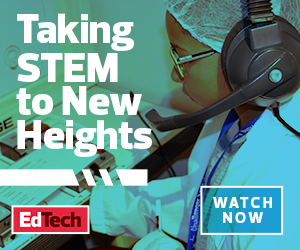

Implementing assistive technologies in the classroom gives students of all abilities a voice in their education.
Micah CasteloMicah Castelo is a web editor for EdTech: Focus on K-12. Her experience includes education and community news coverage for the Syracuse Post-Standard and international news reporting for the Pulitzer Center on Crisis Reporting.
Listen PauseWhen the Academy of Whole Learning, a K–12 private school in Minnesota for students with autism spectrum disorder and individual learning needs, introduced virtual reality technology in their classrooms, students could not contain their excitement.
Using Lenovo VR headsets and Google Expeditions, they took a tour across the world — from the Great Barrier Reef to the North Pole — without ever having to leave their classroom.
Kade Drechsler, a middle school teacher at the school, tells EdTech that the immersive VR experience helped students stay focused and engaged during their lessons. The experience blocked out any classroom distractions and made students feel as if they were actually in the environment they were exploring.
It also gave students an opportunity to practice social skills. “It’s great to see how they build friendships through these virtual experiences,” Drechsler says.


This is just one example of how technology can give students who think and learn differently a more personalized and accessible learning experience.
Referred to as assistive technology, these tools are “any type of equipment or software that helps people to work around the challenges they have, whether that be with learning, communication or mobility,” explains Kara Ball, an elementary science and STEM education specialist for Baltimore City Public Schools and a special education expert at Understood, a nonprofit organization providing support for people with disabilities and their families.
But what types of assistive technology tools are out there? And how can educators best use them in a modern learning environment to help students of all abilities reach their full potential?
Nearly 7 million students in the U.S. — almost 14 percent of all students — received special education in the 2017–2018 school year under the Individuals with Disabilities Education Act (IDEA), according to the most recent figures from the U.S. Department of Education.
To ensure those services are provided and that instruction is inclusive of all learners, school districts are increasingly integrating assistive technology tools in general education classrooms.
Ball categorizes them into two areas: high tech and low tech. High tech refers to devices or equipment with digital or electronic components, such as augmentative communication devices, alternative keyboards and power wheelchairs. It also includes software or built-in accessibility features on devices such as text to speech, word prediction and optical character recognition. Low tech refers to simple adaptive tools such as timers, graphic organizers and flexible furniture.
“Assistive technology really gives students the ability to access grade-level content and allows them to be independent,” Ball says.
As schools increasingly embrace modern learning environments and integrate technology into classrooms and the curriculum, they must also be mindful about potential barriers of technology in special education.
Here are a few ways educators can use digital tools in the classroom to meet the individual needs of their students and help them through learning challenges:
With assistive technology, schools can create more inclusive classrooms and empower students with disabilities to participate in the general education curriculum.
“If I’d had any of those options available to me, I probably would have been a very different student,” says Ball, who has dyslexia and dyscalcula. “Being able to give students these resources to help them be independent is really the benefit of these technologies.”